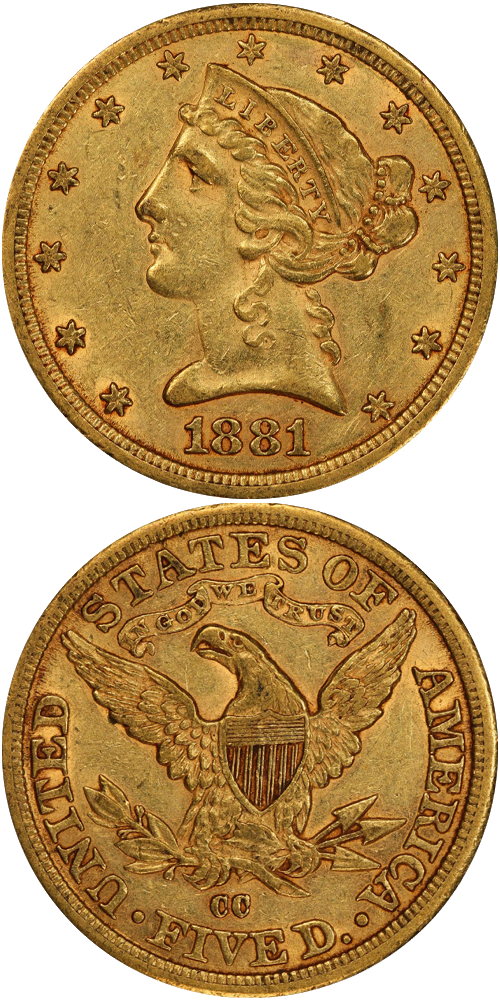1881-CC Liberty Head Half Eagle
Jeff Ambio: The unique die marriage for this issue exhibits a diagonal die scratch through the letters ER in LIBERTY on the obverse, several faint die lines in the recessed area before Liberty's eye and an irregular die defect below Liberty's ear. The 1881-CC introduces a new style of taller, narrower CC mintmark in the Carson City Mint half eagle series, the reverse die of this particular issue with both letters positioned over the V in FIVE.
Rusty Goe: The Carson City Mint welcomed a new chief assayer, Josiah M. Hetrich, in January 1881. The brother of former Carson City Mint Superintendent Frank D. Hetrich, Josiah had replaced William P. Prescott, who had died in December 1880. Josiah Hetrich had formerly served as an assistant in the melting and refining department. Prescott, had he not met an untimely death, would have faced an investigation in February 1881, after the annual assay commissioners had determined that samples from a July 1880 run of silver dollars had not been assayed properly. Since they could not question Prescott, the commissioners simply ordered that the entire July mintage of silver dollars be melted down.
As stated by Mint Director Horatio Burchard in his 1881 annual report, the focus of coinage of gold into denominations less than twenty dollars in face value had continued. The Philadelphia Mint, for instance, delivered a little more than 5.7 million half eagles in 1881 compared to an output of 2,199 double eagles. The San Francisco Mint continued to spew forth a sizable quantity of double eagles in 1881, 727,000 in total; but surpassed it in terms of per-piece count with half eagles, turning out 969,000 examples.
As for the Carson City Mint, its workers felt fortunate to have any business at all, regardless of how minimal it was. The mint had strung together eight consecutive months of operations, albeit on a limited basis, as 1881 began. However, a headline in the March 29, 1881 Daily Nevada Tribune, announced the employees' worst fear: "Another Black Eye" for the Carson Mint. The government had shut it down again, effective April 1, 1881. By this time, the coining department had contributed 5,640 gold half eagles to the nation's effort to bulk up its supply of that small denomination.
Finally, in November, the presses started up again and small quantities of silver dollars and gold eagles and half eagles were struck. During the last two months of the year 8,246 half eagles were struck.
Q. David Bowers: Of the 13,886 half eagles minted at Carson City in 1881 Rusty Goe estimates 150 to 190 exist, with four or five Uncirculated. My estimates are 60 to 100 in circulated grades and four to six Mint State.
This is considered to be the rarest of the later Carson City half eagles following the incredibly elusive issues of the 1870s. Fine, VF, and EF are typical grades. AU coins are very elusive. David Akers viewed the piece as distinctly underappreciated, commenting: "Fully in the same rarity class as the dates from 1871 to 1877."
The example to the left was sold by Stack's Bowers Galleries in the Fairmont Collection, Hendricks Set, where it realized $18,000.






